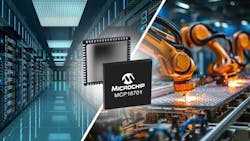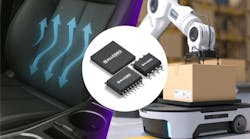PMIC Fits Space-Starved AI, Industrial Computing, Data Center Apps
Leveraging high-performance MPUs and FPGAs, Microchip Technology's MCP16701 power-management integrated circuit (PMIC) is a compact and flexible solution that addresses space-constrained applications.
The PMIC integrates eight 1.5-A buck converters that can be paralleled, four 300-mA internal low-dropout voltage regulators (LDOs), and a controller to drive external MOSFETs. Microchip said the chip can help designers reduce PCB footprint by up to 48% while reducing the component count by more than 60% over a discrete solution.
A key feature of the MCP16701 is its ability to dynamically change VOUT levels for all converters in 12.5- and 25-mV increments, which makes it possible for designers to fine-tune power delivery to meet specific application requirements. The PMIC also has an I2C communication interface to simplify and enhance communication efficiency between the PMIC and Microchip’s PIC64-GX MPUs and PolarFire FPGAs, as well as other system components. It’s supported by the EV23P28A Evaluation Board.
The MCP16701 comes in a small-form-factor, 8- × 8-mm VQFN package and is priced at $3.00 each in 10,000-unit quantities. To learn more, visit Microchip’s power-management products web page.
Next in This Edition of PowerBites
More PowerBites
About the Author
Lee Goldberg
Contributing Editor
Lee Goldberg is a self-identified “Recovering Engineer,” Maker/Hacker, Green-Tech Maven, Aviator, Gadfly, and Geek Dad. He spent the first 18 years of his career helping design microprocessors, embedded systems, renewable energy applications, and the occasional interplanetary spacecraft. After trading his ‘scope and soldering iron for a keyboard and a second career as a tech journalist, he’s spent the next two decades at several print and online engineering publications.
Lee’s current focus is power electronics, especially the technologies involved with energy efficiency, energy management, and renewable energy. This dovetails with his coverage of sustainable technologies and various environmental and social issues within the engineering community that he began in 1996. Lee also covers 3D printers, open-source hardware, and other Maker/Hacker technologies.
Lee holds a BSEE in Electrical Engineering from Thomas Edison College, and participated in a colloquium on technology, society, and the environment at Goddard College’s Institute for Social Ecology. His book, “Green Electronics/Green Bottom Line - A Commonsense Guide To Environmentally Responsible Engineering and Management,” was published by Newnes Press.
Lee, his wife Catherine, and his daughter Anwyn currently reside in the outskirts of Princeton N.J., where they masquerade as a typical suburban family.
Lee also writes the regular PowerBites series.





